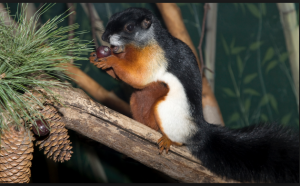
If you have the latest (2018) Puppy Up Foundation Calendar you already know that today, Sunday the 21st, is Squirrel Appreciation Day. It falls on January 21st every year, and it’s something all dogs look forward to. Well, to be honest, every day is squirrel appreciation day to dogs.
But what does your dog really know about squirrels, other than they’re fun to chase, pretty hard to catch, and will scold him and pelt him with nuts from high above in the treetops?
Well, to be frank, your dog doesn’t care a thing about these fascinating squirrel facts.
But, even though your dog doesn’t care, and squirrels often get a bad rap — they raid bird feeders, they can chew through just about anything, they dart out in front of cars — we hope that, in spite of these shortcomings, you find these few squirrely facts interesting.

Japanese-flying-squirrel “Pteromys-momonga” from Flickr. Photo by Keishiro Shin.
1. Flying squirrels are exceedingly cute
Check out the Japanese flying squirrel Pteromys momonga. These little balls of fur, which live on the islands of Honshu, Shikoku, and Kyushu, are often thought to resemble animé characters, such as Pikachu from Pokemon.
“They are famous for their adorableness,” says Keishiro Shin, a wildlife photographer in Japan. “Many people are fascinated by their big cute eyes.”
Photographing these amazing animals however, can be incredibly difficult as they blend so well with the coloration of the tree bark that they practically become invisible.
“It takes a long time to photograph flying squirrels,” Shin explains. “First, I have to find their nest and then wait quietly in the freezing weather until they come out. Sometimes they come out. Mostly they don’t. Even when they do come out, they just fly away.
It’s tough, but it’s worth it when they start eating on a tree just in front of me.”
While it may look like it, Japanese flying squirrels don’t actually fly. These animals use a furry membrane that extends from their ankles to their wrists to glide from tree to tree.
2. They chew for a reason.
“The reason they are chewing on things is because they have incisors — front teeth — that are always growing,” McCleery explained.
“If they don’t chew on something, their teeth are going to grow into their lower jaw and skull.” To avoid that, squirrels will chew on anything that helps wear down their teeth.

California ground squirrel “Otospermophilus-beecheyi” Photo by Wade Tregaskis. Flikr.
3. Squirrels can survive rattlesnake bites
A squirrel may look like a tasty meal to a rattlesnake, but the snake might want to think twice before hunting the California ground squirrel Otospermophilus beecheyi.
“California ground squirrels are well adapted to living around rattlesnakes,” says Kayce Bell, a Peter Buck Postdoctoral Fellow at the Smithsonian’s National Museum of Natural History. “They actually have the ability to neutralize snake venom.”
Researchers have witnessed these ground squirrels beat up rattlesnakes and not feel any ill effects. While the adults may have more bravado around rattlesnakes, squirrel pups need to be warier. Ground squirrel pups are a staple of the rattlesnake’s diet, with their small body sizes juveniles are unable to neutralize a full dose of venom.
Understanding how adult California ground squirrels survive bites that could dangerously sicken or even kill a human is of immense interest to researchers. Finding the mechanisms that neutralize venom toxins could help the development of safer, more effective antivenin for people bitten by rattlesnakes.

Chipmunk Photo by Mark Rounds. Flikr
4. Chipmunks are squirrels
Yes, Alvin and his friends will be celebrating National Squirrel Appreciation Day too!
“Chipmunks are actually ground squirrels,” Bell explains. “There are three types of squirrels in North America which all share a common ancestor: tree squirrels, flying squirrels, and ground squirrels.
Chipmunks along with groundhogs (also known as woodchucks), marmots, and prairie dogs are all considered ground dwelling squirrels. All squirrels are members of the family Sciuridae.

The gray squirrel is common in Florida. Photo. Mike Lane 45. Getty Images. iStockphoto
5. They are nature’s gardeners.
Squirrels have an important ecological role, especially in forest ecosystems, McCleery said.
“Their biggest contribution to the forest is in shaping plant composition. They have a peculiar habit of taking seeds, which are their main source of nutrients, and burying them. They bury them throughout the environment, and often, when they go back and look for them, they forget where they are. When that happens, they are effectively planting seeds,” McCleery said.
Over time, this behavior, called caching, changes the composition of a forest.
“They will expand forests and change the types of trees that are there,” he said. In Florida, for example, they have an important role in maintaining the native long-leaf pine ecosystem, McCleery said.

A hoary marmot “Marmota caligata” sunning on the rocks in Mt. Rainier National Park.Photo by Ralph Arvesen. Flickr
6. The heaviest recorded squirrel weighed in at 30 pounds!
The biggest of all squirrels are the marmots. The hoary marmot, Marmota caligata, is well known to hikers in the western mountains of North America, where its high-pitched warning whistle often welcomes visitors to the alpine country.
Feeding on lush alpine plants, these marmots bulk up to spend the winter months in hibernation in burrows far beneath the snow. Gaining a thick layer of fat before their long hibernation, hoary marmots usually weigh 11 to 20 pounds just before winter, but have been recorded as heavy as 30 pounds!

An Arctic squirrel in summer. Photo by Tim Rains. Flikr
7. This one kind of squirrel can lower its body temperature below freezing
Do the snow and the wind make you shiver? Then spare a thought for the Arctic squirrel, whose blood literally does run cold!
“Arctic ground squirrels can lower their body temperature below freezing when they hibernate but somehow they do not turn into ice blocks,” Bell explains.
These squirrels spend eight months of the year in the longest and deepest hibernation of any animal on earth. During this time their core body temperature drops to a staggering 26.7 degrees F, almost 5 degrees below the freezing point of water. Despite this, ground squirrel blood remains liquid, most likely through a phenomenon known as supercooling. Brrrrr!
8. They have some zany behaviors that are entertaining to watch.
Squirrels have some behaviors that may be puzzling to humans, McCleery said.
For example, if you see a squirrel rubbing its face on an acorn, that’s the squirrel marking the seed with its scent, increasing the chances it will find it later.
Ever see one squirrel in hot pursuit of another squirrel? That’s a mating chase, McCleery said.
9. They will tell you off.
“If you’re in your backyard, walking across a college campus or through a park, you might hear squirrels. They make a rolling chirping noise,” McCleery said. As they make that noise, they may also rapidly flick their tails over their heads.
All this is the squirrel’s way of saying, Back off!
They’ll often do this when another squirrel is nearby, McCleery said. Or, if they spot you walking your dog, which they see as a potential predator, they might go on the defensive.
“But if there isn’t another squirrel around and you’re not walking your dog, they may actually be making that sound at you. They are scolding you because you are near a tree they’ve utilized or are near some food resource, or you’re also perceived as a predator,” McCleery said.
10. There are many species of squirrel, and they come in lots of shapes, colors and sizes.
“There are three squirrels commonly found in Florida. The gray squirrel is smaller than the others and is gray in color. The fox squirrel, on the other hand, is larger than the gray squirrel, and is the most variably colored mammal in North America,” McCleery said.
A third and smallest type of squirrel, the flying squirrel, is fairly common, though you’ll rarely see one, said McCleery. That’s because this squirrel is nocturnal.
“But you can hear them,” McCleery said. “Just go outside at dusk, and listen for a high-pitched squeaking noise, which sounds like a screen door, coming from the tops of the trees.”
Flying squirrels get their name from the flaps of skin between their front and back legs. These flaps allow them to glide from one tree to the next. “That’s probably going on in your backyard tonight,” McCleery said.

Prevost’s squirrel “Callosciurus prevosti” Smithsonian National Zoo photo
11. Squirrels rock funky hairstyles
Prevost’s squirrels, Callosciurus prevosti, look like a North American squirrel with a fancy paint job. With the genus name Callosciurus meaning “beautiful squirrel,” it is renowned for being one of the most colorful of all squirrels. Their amazing colors however have a purpose.
“These are beautiful animals. Their coloring helps them blend into their tropical forest habitats,” explains Ashton Ball, small mammal keeper at the Smithsonian’s National Zoo.
Prevost’s squirrels live in the lowland and montane forests of the Malay Peninsula, Sumatra, Borneo, Bangka Island, Rhio Archipelago, Sulawesi, and the East Indies. The can also be found in cultivated areas and gardens where they can be seen jumping and climbing throughout the day.

Sources:
http://insider.si.edu/2018/01/squirrel-appreciation-day-sunday-jan-21-surprising-squirrely-facts/








